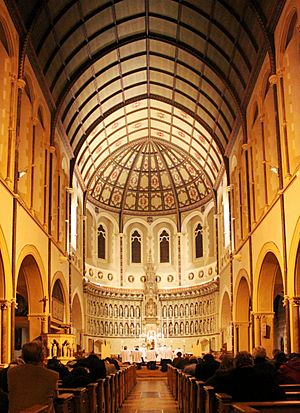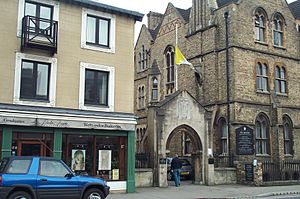Oxford Oratory facts for kids
Quick facts for kids Oxford Oratory |
|
|---|---|
| Oxford Oratory Church of St Aloysius Gonzaga | |

Oxford Oratory
|
|
| 51°45′34″N 1°15′42″W / 51.759343°N 1.261763°W | |
| OS grid reference | SP 51049 07002 |
| Location | Oxford |
| Country | England |
| Denomination | Catholic Church |
| Religious order |
|
| Architecture | |
| Heritage designation | Grade II listed |
| Architect(s) | Joseph Hansom |
| Completed | 1875 |
| Administration | |
| Archdiocese | Birmingham |
The Oxford Oratory Church of St Aloysius Gonzaga, often called the Oxford Oratory, is a special Catholic church in the heart of Oxford, England. It's located at 25 Woodstock Road, right next to Somerville College. This church is looked after by a group of priests called the Oratorians.
Contents
History of the Oxford Oratory

St Aloysius' was first started by the Jesuits, a group of Catholic priests. It was meant to be the main Catholic church for central Oxford. A generous lady named Baroness Weld, who had become Catholic, gave £7,000 to help build it.
The church was finished in 1875. For many years, important Jesuits served there, including Gerard Manley Hopkins, a famous poet. The church also had a collection of special religious items called relics. Sadly, many of these were destroyed in the 1970s.
In the 1980s, the Jesuits left the church. The Archdiocese of Birmingham then took over. In 1990, the Archbishop of Birmingham invited priests from the Birmingham Oratory to come and run the church in Oxford.
Two priests arrived in September 1990. By 1993, the Oxford Oratory became its own independent community. Fr Robert Byrne was the leader, called a provost, from 1993 to 2011. After him, Fr Daniel Seward was provost until 2019. The current provost is the Very Rev. Fr Nicholas Edmonds-Smith.
Church Services and Traditions
A key tradition of the Oratory in England is to make sure that church services, known as the liturgy, are celebrated in a very respectful and special way.
At the Oxford Oratory, most Masses are held in English. However, on Sundays and special holy days, a special Mass is sung in Latin. This is called a non-Tridentine Solemn Mass.
A different type of Latin Mass, called the Tridentine Low Mass, is also celebrated on Sundays and holy days. The main Parish Mass, however, is sung in English.
The Church Organ
The organ in the church was made bigger and improved between 1998 and 2004 by Matthew Copley. You can find more details about this organ on the National Pipe Organ Register.
Building and Design
The church was designed by Joseph Hansom. He used a style called Gothic Revival, which looks like older medieval churches. In the 1970s, much of the original artwork inside was painted over. Also, the altar, which is the table where Mass is celebrated, was moved forward.
The church is slowly being restored to its original beauty. This project is part of the Oratory's "Reaffirmation and Renewal" campaign, which started raising money in 2007. In 2024, two 'lost' murals by Gabriel Pippet were brought back to life by Cliveden Conservation.
The church has one main hall, called a nave, and five smaller chapels on the sides. On the left side of the sanctuary (the area around the altar) is the Sacred Heart chapel. The Lady Chapel is on the right.
There are also chapels dedicated to St Philip Neri and Our Lady of Oxford. The Our Lady of Oxford chapel is also known as the relic chapel because it used to hold special religious items. In 2010, a special shrine was created for St John Henry Newman after he was made a saint. There are also plans to build a new baptistery, which is a place for baptisms.
Gallery




